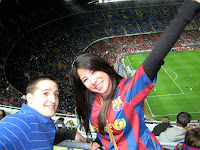
 As my semester in Barcelona comes to a close, I cannot believe how quickly my four months in this wonderful city flew by. I came to Barcelona with apprehensions--I was nervous about the extreme differences in culture between Spain and America and I thought that I would be homesick. In retrospect, the last four months have honestly been the best months of my life. I cannot believe how lucky I am to have been able to enjoy this experience. So many things have contributed to my incredible semester, from my travel experiences, to the people I have met, to the amazing city I lived in.
As my semester in Barcelona comes to a close, I cannot believe how quickly my four months in this wonderful city flew by. I came to Barcelona with apprehensions--I was nervous about the extreme differences in culture between Spain and America and I thought that I would be homesick. In retrospect, the last four months have honestly been the best months of my life. I cannot believe how lucky I am to have been able to enjoy this experience. So many things have contributed to my incredible semester, from my travel experiences, to the people I have met, to the amazing city I lived in.One reason why I chose to study in Barcelona was because it is in a good location central to Europe and close to many other amazing cities. Traveling from Barcelona to cities all over Europe is very easy and during this past semester, I have gotten to experience more world-famous sights and cultures than many people get to see in their lifetimes. I have stood at the Berlin wall, explored Amsterdam, ridden a gondola in Venice, toured the Colosseum in Rome, skied in the Swiss alps, and watched the waves crash against the shore in beautiful San Sebastian. I shopped in Milan, ate pasta and gelato in Florence, and lounged on the beaches of Ibiza and Formentera, and I plan to make one last stop in Greece before heading home to Boston, Massachusetts. Through traveling, I have learned so much and grown as a person. Not only have I learned how to achieve the physical aspects of traveling, such as budgeting, planning my own transportation and accommodations, and getting myself from place to place, but I have also learned how to mentally adapt to different cultures and keep an open mind. After all of these wonderful trips, I definitely feel that I have developed a great passion for traveling that will stay with me throughout my life.
Although I have loved traveling, I never needed to stray from Barcelona city in order to learn, grow, and have a wonderful semester. I have had so many great experiences within the city. In addition to the cultural and leisure activities I have described, I have visited the famous and breathtaking Parc Guell, the famed Gaudi apartment Casa La Pedrera, eaten fresh fruit from La Boqueria market, layed on the beach by the Mediterranean sea, discovered the wonders of trendy El Born and the medieval Gothic quarter, viewed famous art at the Picasso Museum, picnicked at La Ciutadella park, and so much more. I have discovered so many great restaurants in addition to the three that I blogged about. I have sampled traditional Catalan food like tuna croquettes and patatas bravas and enjoyed fun Mexican food at Rosa Negra, Asian fusion tapas at Mosquito's, and Greek specialties at Ugarit. I have been able to accomplish one of my main goals in coming abroad, which was to improve my Spanish language skills. I have learned how to truly live on my own independently and how to adapt to another culture.
After spending four months living in a place with a completely different language, different food, and a different daily schedule, I feel that I could adapt to any conditions that I may come across throughout my life. I found the culture in Spain to be much more laid-back and less fast-paced than American culture, and I think that living in Barcelona has enabled me to learn how to slow down, relax, and take a moment to enjoy the little things in life. I will take this new attitude back to the United States with me. In addition, I have met so many great people that I will not soon forget. I am so thankful to have had this experience and I will miss Barcelona so much. I know I will be back someday so for now I will say Barcelona, hasta luego!
















































